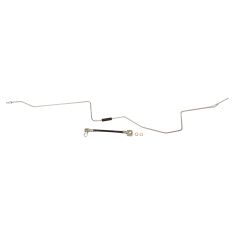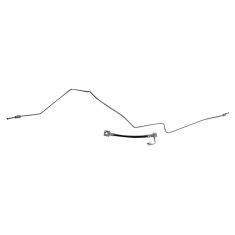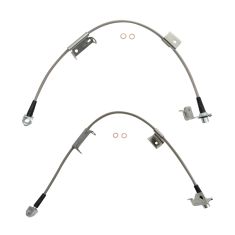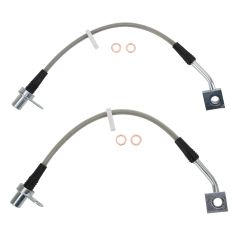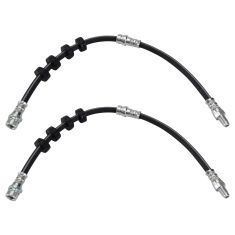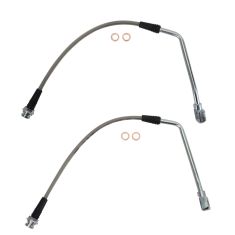Brake Hoses, Lines, and Fittings
-
-
- Air Deflectors & Valance Panels
- Battery Trays & Related
- Body Panels
- Bumpers & Related - Front & Rear
- Convertible Tops, Soft Tops, & Parts
- Decal & Stripe Kits
- Emblems & Nameplates
- Engine Compartment Trim
- Frame Parts & Bushings
- Fuel Door Parts
- Fuel Tank Filler Neck
- Grille
- Header Panel
- Hood & Hatch Lift Supports
- Hood Latch & Catch Brackets
- Hood Release Cable
- Jack Pads
- Radiator Supports
- Rust Repair Panels
- Splash Shields & Fender Liners
- Tailgate Cables
- Tailgate Hinges & Related
- Weatherstripping
-
- Exterior Lighting
- Exterior Parts & Accessories
- Fender Flares
- License Plate Brackets & Frames
- Mud Flaps & Splash Guards
- Nerf Bars, Side Steps, Running Boards
- Radio Antenna
- Rain Deflectors
- Roll Bars, Light Bars, & Related
- Skid Plates
- Spare Tire Carriers & Related
- Tonneau Covers
- Tow Hooks & D-Shackles
- Trailer Hitch & Components
-
- Accelerator Pedals & Sensors
- Cruise Control Switch & Lever
- Electrical Parts
- Hazard Switch
- Ignition Key Lock Cylinder
- Ignition Switch
- Keyless Entry Remote & Related
- Neutral Safety Switch
- Parking Assist Cameras & Monitors
- Power Mirror Switch
- Power Seat Switches
- Power Window Switch
- Radio, Navigation, Entertainment
- Reverse Light Switch
- Trunk Release & Lock Solenoids
- Turn Signal Switches and Levers
- Windshield Wiper Switch
-
- Idler Arm
- Pitman Arm
- Power Steering Hoses
- Power Steering Pressure Sensor
- Power Steering Pump
- Power Steering Pump Pulley
- Power Steering Pump Reservoir
- Steering Dampers
- Steering Knuckles and Spindles
- Steering Rack and Gear Boxes
- Steering Shafts & Couplers
- Steering Wheels & Column Parts
- Tie Rods & Adjusting Sleeves
-
-
-
2638
264
10
10
-
Notify When Available
Replaces Chevrolet GMC Front Driver & Passenger Side 2 Piece Stainless Steel Performance Brake Hose Set TRQ Performance BLA63343
Brand: TRQ Performance- BLA63343$54.95Save 33%List $81.95 Save $27.00Brand: TRQ Performance - BLA63343$54.95Save 33%List $81.95 Save $27.00 -
Notify When Available
Replaces Dodge Ram 1500 Rear Passenger Side Replacement Brake Hose TRQ BLA70873
Brand: TRQ- BLA70873$59.95Save 26%List $80.95 Save $21.00Brand: TRQ - BLA70873$59.95Save 26%List $80.95 Save $21.00 -
Notify When Available
Replaces Dodge Ram 2500 3500 Ram 2500 3500 Rear Passenger Side Replacement Brake Hose TRQ BLA62340
Brand: TRQ- BLA62340$59.95Save 22%List $76.95 Save $17.00Brand: TRQ - BLA62340$59.95Save 22%List $76.95 Save $17.00 -
Notify When Available
Replaces Chevrolet GMC Cadillac Front Driver & Passenger Side 2 Piece Stainless Steel Performance Brake Hose Set TRQ Performance BLA63323
Brand: TRQ Performance- BLA63323$94.95Save 26%List $128.95 Save $34.00Brand: TRQ Performance - BLA63323$94.95Save 26%List $128.95 Save $34.00 -
Notify When Available
Replaces Chevrolet GMC Cadillac Rear Driver & Passenger Side 2 Piece Stainless Steel Performance Brake Hose Set TRQ Performance BLA64389
Brand: TRQ Performance- BLA64389$54.95Save 23%List $70.95 Save $16.00Brand: TRQ Performance - BLA64389$54.95Save 23%List $70.95 Save $16.00 -
Notify When Available
Replaces Chevrolet GMC Cadillac Front Driver & Passenger Side 2 Piece Stainless Steel Performance Brake Hose Set TRQ Performance BLA63319
Brand: TRQ Performance- BLA63319$69.95Save 31%List $100.95 Save $31.00Brand: TRQ Performance - BLA63319$69.95Save 31%List $100.95 Save $31.00 -
Notify When Available
Replaces Ford F150 F150 Heritage Rear Driver & Passenger Side 2 Piece Brake Hose Set TRQ BLA63874
Brand: TRQ- BLA63874$99.95Save 29%List $139.95 Save $40.00Brand: TRQ - BLA63874$99.95Save 29%List $139.95 Save $40.00 -
Notify When Available
Replaces Dodge Ram Front Driver & Passenger Side 2 Piece Stainless Steel Performance Brake Hose Set TRQ Performance BLA63330
Brand: TRQ Performance- BLA63330$68.95Save 34%List $103.95 Save $35.00Brand: TRQ Performance - BLA63330$68.95Save 34%List $103.95 Save $35.00 -
Notify When Available
Replaces Ford Mazda Mercury Front Driver & Passenger Side 2 Piece Brake Hose Set TRQ BLA63672
Brand: TRQ- BLA63672$44.95Save 17%List $53.95 Save $9.00Brand: TRQ - BLA63672$44.95Save 17%List $53.95 Save $9.00 -
Notify When Available
Replaces Chevrolet GMC Cadillac Front Driver & Passenger Side 2 Piece Stainless Steel Performance Brake Hose Set TRQ Performance BLA63346
Brand: TRQ Performance- BLA63346$49.95Save 33%List $74.95 Save $25.00Brand: TRQ Performance - BLA63346$49.95Save 33%List $74.95 Save $25.00
loading...
Choose the Make of Your Vehicle

